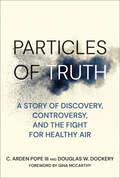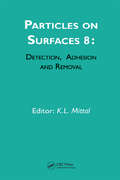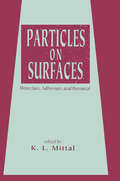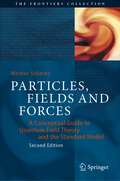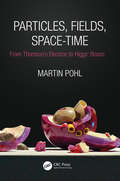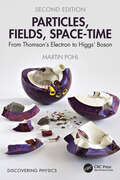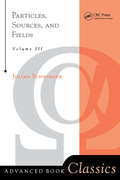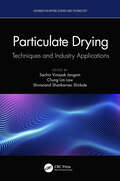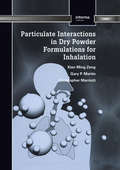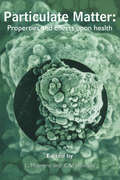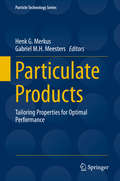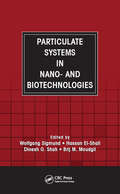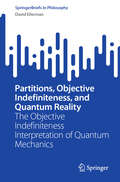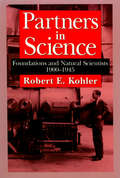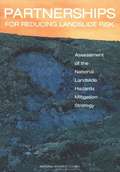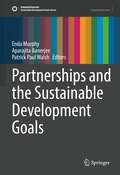- Table View
- List View
Particles of Truth: A Story of Discovery, Controversy, and the Fight for Healthy Air
by C. Arden Pope III Douglas W. DockeryA compelling, real-life account of how scientists uncovered air pollution&’s deadly impact on human health—and the contentious battles to use key scientific evidence in the critical fight for clean air.Particles of Truth is a riveting account of the discovery of the critical health effects of air pollution told by Arden Pope and Douglas Dockery, who have been at the forefront of air pollution and health research for four decades. With an insightful foreword by former EPA Administrator Gina McCarthy, this compelling book provides an inside look at groundbreaking scientific research and ensuing political and public-policy battles. It presents evidence that air pollution is a major contributor to disease and death and that reducing air pollution saves lives. The book also delves into intense efforts to discredit and cast doubt on the science.Through firsthand accounts, Pope and Dockery bring the scientific discoveries regarding the health effects of air pollution and accompanying controversies to life. They describe the real-world challenges of conducting impactful research when public health clashes with economic interests and politics. Despite these challenges, they and their colleagues persisted, accumulating evidence that supports landmark clean-air legislation and pollution reduction efforts worldwide. More than an inside look at pioneering air pollution research and the hidden health burden of air pollution, Particles of Truth is a story of determination and perseverance by those working to protect air quality and our health; indeed, their efforts have contributed to improvements in public health and an increase in longevity. For anyone interested in public health, environmental quality, or public policy, this is a must-read book that takes you to the front lines of discovery and controversy.
Particles on Surfaces: Detection, Adhesion And Removal
by K. L. MittalThis volume documents the proceedings of the 7th International Symposium on Particles on Surfaces: Detection, Adhesion and Removal held in Newark, NJ, June 19-21, 2000. The study of particles on surfaces is extremely important in a host of diverse technological areas, ranging from microelectronics to optics to biomedical. This volume contains a total of 28 papers, which were all properly peer reviewed, revised and edited before inclusion. Therefore, this book is not merely a collection of unreviewed manuscripts, but rather represents information which has passed peer scrutiny. Furthermore, the authors were asked to update their manuscripts, so the information contained in this book should be current and fresh. This volume is divided into two parts: 1) Particle Analysis and General Cleaning-Related Topics; and 2) Particle Adhesion and Removal. The topics covered include: surface analysis techniques for particle identification; cleaning, rinsing and drying issues in post-CMP cleaning; fundamental forces involved in particle adhesion; factors affecting adhesion of small (nanosize) particles; factors important in particle detachment; particle adhesion measurement by AFM; various (wet and dry) techniques for particle removal, e.g., laser, ultrasonic, megasonic, use of surfactants; toner particles and pharmaceutical particles. This volume offers a wealth of information on the tremendously technologically important field of particles on surfaces and should provide a consolidated source of current R&D activity in this arena. Therefore, it will be of value and use to anyone interested in the topic of particles on surfaces.
Particles on Surfaces: Detection, Adhesion and Removal, Volume 8
by K. L. MittalThis volume documents the proceedings of the 8th International Symposium on Particles on Surfaces: Detection, Adhesion and Removal held in Providence, Rhode Island, June 24a 26, 2002. The study of particles on surfaces is extremely crucial in a host of diverse technological areas, ranging from microelectronics to optics to biomedical. In a world o
Particles on Surfaces: Detection: Adhesion, and Removal
by K. L. MittalThis work comprises the proceedings of the Fourth Symposium on Particles on Surfaces. Papers cover: adhesion-induced deformations of particles on surfaces; the use of atomic force microscopy in probing particle-particle adhesion; particle contamination in microelectronics, on spacecraft, and on optical surfaces; the role of air ionization in reducing surface contamination by particles in the cleanroom; abrasive blasting media for contamination-free deburring processes; and more.;The book is intended for physical, chemical, surface and colloid chemists, materials scientists; polymers, plastics, electrical and electronics, computer, chemical and mechanical engineers; and upper-level undergraduate and graduate students in these disciplines.
Particles, Fields and Forces: A Conceptual Guide to Quantum Field Theory and the Standard Model (The Frontiers Collection)
by Wouter SchmitzThis book provides unique and comprehensive conceptual explanations of quantum field theory and the standard model of particle physics. How can fundamental particles exist as waves in the vacuum? How can such waves have particle properties such as inertia? What is behind the notion of virtual particles? Why and how do particles exert forces on one another? Not least: What are forces anyway? These are some of the central questions that have intriguing answers in Quantum Field Theory and the Standard Model of Particle Physics. Unfortunately, these theories are highly mathematical, so that most people—even many scientists—are not able to fully grasp their meaning. This book untangles these theories in a conceptual non-mathematical way, using more than 190 figures and extensive explanations and will provide the nonspecialist with great insights that are not to be found in the popular science literature. This fully revised and expanded second edition adds remarkable insights into the transition from quantum to classical world using the concepts of quantum decoherence, while also explaining "collapse of the wave function", tunnelling and quantum computing.
Particles, Fields, Quanta: From Quantum Mechanics to the Standard Model of Particle Physics (Undergraduate Lecture Notes in Physics)
by Gerhard EckerThis book provides an introduction to the current state of our knowledge about the structure of matter. Gerhard Ecker describes the development of modern physics from the beginning of the quantum age to the standard model of particle physics, the fundamental theory of interactions of the microcosm. The focus lies on the most important discoveries and developments, e.g. of quantum field theory, gauge theories and the future of particle physics. The author also emphasizes the interplay between theory and experiment, which helps us to explore the deepest mysteries of nature."Particles, Fields, Quanta" is written for everyone who enjoys physics. It offers high school graduates and students of physics in the first semesters an encouragement to understand physics more deeply. Teachers and others interested in physics will find useful insights into the world of particle physics. For advanced students, the book can serve as a comprehensive preparation for lectures on particle physics and quantum field theory. A brief outline of the mathematical structures, an index of persons with research focuses and a glossary for quick reference of important terms such as gauge theory, spin and symmetry complete the book.From the foreword by Michael Springer:“The great successes and the many open questions this book describes illustrate how immensely complicated nature is and nevertheless how much we already understand of it.”The authorGerhard Ecker studied theoretical physics with Walter Thirring at the University of Vienna. His research focus has been on theoretical particle physics, in particular during several long-term visits at CERN, the European Organisation for Nuclear Research in Geneva. In 1986 he was promoted to Professor of Theoretical Physics at the University of Vienna. Since 1977 he has given both basic lectures in theoretical physics and advanced courses on different topics in particle physics, e.g., quantum field theory, symmetry groups in particle physics and renormalisation in quantum field theory.
Particles, Fields, Space-Time: From Thomson’s Electron to Higgs’ Boson
by Martin PohlCHOICE Highly Recommended 2021Particles, Fields, Space-Time: From Thomson's Electron to Higgs' Boson explores the concepts, ideas, and experimental results that brought us from the discovery of the first elementary particle in the end of the 19th century to the completion of the Standard Model of particle physics in the early 21st century. The book concentrates on disruptive events and unexpected results that fundamentally changed our view of particles and how they move through space-time. It separates the mathematical and technical details from the narrative into focus boxes, so that it remains accessible to non-scientists, yet interesting for those with a scientific background who wish to further their understanding. The text presents and explains experiments and their results wherever appropriate.This book will be of interest to a general audience, but also to students studying particle physics, physics teachers at all levels, and scientists with a recreational curiosity towards the subject.Features Short, comprehensive overview concentrating on major breakthroughs, disruptive ideas, and unexpected results Accessible to all interested in subatomic physics with little prior knowledge required Contains the latest developments in this exciting field
Particles, Fields, Space-Time: From Thomson’s Electron to Higgs’ Boson (Discovering Physics)
by Martin PohlParticles, Fields, Space-Time: From Thomson’s Electron to Higgs’ Boson explores the concepts, ideas, and experimental results that brought us from the discovery of the first elementary particle in the end of the 19th century to the completion of the Standard Model of particle physics in the early 21st century. The book concentrates on disruptive events and unexpected results that fundamentally changed our view of particles and how they move through space-time. It separates the mathematical and technical details from the narrative into focus boxes, so that it remains accessible to non-scientists, yet interesting for those with a scientific background who wish to further their understanding. The text presents and explains experiments and their results wherever appropriate. This book is of interest to a general audience but also to students studying particle physics, physics teachers at all levels, and scientists with a recreational curiosity towards the subject. For this second edition, the complete text has been thoroughly revised. A description of plans for new accelerator facilities has been added, as well as new results on cosmic ray physics, dark matter and dark energy. The usage of natural units has been abandoned in favour of SI units throughout the text.Key Features: Short, comprehensive overview concentrating on major breakthroughs, disruptive ideas, and unexpected results Accessible to all interested in subatomic physics with little prior knowledge required Contains the latest developments in this exciting field
Particles, Sources, And Fields, Volume 1 (Advanced Books Classics Ser. #1)
by Julian SchwingerThis classic, the first of three volumes, presents techniques that emphasize the unity of high-energy particle physics with electrodynamics, gravitational theory, and many-particle cooperative phenomena. What emerges is a theory intermediate in position between operator field theory and S-matrix theory, which rejects the dogmas of each and gains thereby a calculational ease and intuitiveness that make it a worthy contender to displace the earlier formulations.
Particles, Sources, And Fields, Volume 2 (Advanced Books Classics Ser. #1)
by Julian SchwingerThis classic book (volume two of three volumes) is almost exclusively concerned with quantum electrodynamics. As such, it is retrospective in its subject matter. The topics discussed range from anomalous magnetic moments and vacuum polarization, in a variety of applications, to the energy level displacements in hydrogenic atoms, with occasional excursions into nuclear and high-energy physics. Based as it is upon the conceptually and computationally simple foundations of source theory, little in the way of formal mathematical apparatus is required, and thus most of the book is devoted to the working out of physical problems.
Particles, Sources, And Fields, Volume 3 (Advanced Books Classics Ser. #1)
by Julian SchwingerAn extension of Dr. Schwinger's two previous classic works, this volume contains four sections in addition to the previous sections of Electrodynamics II, which were concerned with the two-particle problem, and applications to hydrogenic atoms, positronium, and muonium.
Particulate Drying: Techniques and Industry Applications (Advances in Drying Science and Technology)
by Sachin Vinayak Jangam Chung Lim Law Shivanand Shankarrao ShirkoleIn the process industry, understanding the unit operation of particulate drying is imperative to yield products with desired properties and characteristics and to ensure process safety, optimal energy efficiency and drying performance, as well as low environmental impact. There are many techniques and tools available, which can cause confusion. Particulate Drying: Techniques and Industry Applications provides an overview of various particulate drying techniques, their advantages and limitations, industrial applications, and simple design methods. This book: • Covers advances in particulate drying and their importance in the process industry • Highlights recent developments in conventional drying techniques and new drying technologies • Helps readers gain insight into selecting the appropriate drying techniques for a particular product • Summarizes various applications from a wide range of industries, including chemical, food, pharmaceutical, biotech, polymer, mineral, and agro-industries • Projects future research trends and demands in particulate drying This book serves as a reference for process and plant engineers as well as researchers in the fields of particulate processing, mineral processing, food processing, chemical engineering, and mechanical engineering, especially those involved in the selection of drying equipment for particulate solids and R&D of drying of particulate materials.
Particulate Gravity Currents: Theory, Experiments, and Environmental Applications (Geophysical Monograph Series)
by Benjamin Kneller Eckart Meiburg Bernhard Vowinckel Zhiguo HeExploring the properties, behavior, and dynamics of particulate gravity currents Theory, Experiments, and Environmental Applications Particulate gravity currents involve the movement of mixtures of particles and fluid under the influence of gravity. Examples in the natural environment include snow avalanches, pyroclastic flows, and seafloor turbidity currents. Understanding how particles move, mix, stratify, and settle has applications such as hazard mitigation and pollution management. Particulate Gravity Currents: Theory, Experiments, and Environmental Applications presents experimental, numerical, and field studies of particulate gravity currents, offering new insights into their properties, behavior, and dynamics. Volume highlights include: Explorations of cohesive and non-cohesive sediment and transport Applications of theoretical understanding to real-world subaerial and subaqueous processes Studies using the latest techniques, including 3D numerical simulation Broader relevance beyond the natural environment to other types of particulate and non-particulate gravity currents
Particulate Interactions in Dry Powder Formulation for Inhalation
by Xian Ming Zeng Gary Peter Martin Christopher MarriottInteractions between drug particulates are crucial in determining drug dispersion and deaggregation, and ultimately delivery efficiency. This book combines principles and factors in pharmaceutical powder technology, critically reviews some of the studies carried out in dry powder formulation development, and proposes possible strategies for improvi
Particulate Matter: Properties and Effects on Health
by Dr R Maynard Vyvyan HowardThis is a rapidly expanding and highly topical research area. Written by authors and editors who are well known and respected in their fields, this text looks at the health effects caused by particulate aerosols, and discusses recent legislation and future strategies.
Particulate Plastics in Terrestrial and Aquatic Environments
by Nanthi S. Bolan, M.B. Kirkham, Claudia Halsband, Dayanthi Nugegoda, Yong Sik OkThe manufacture of plastic as well as its indiscriminate disposal and destruction by incineration pollutes atmospheric, terrestrial, and aquatic ecosystems. Synthetic plastics do not break down; they accumulate in the environment as macro-, micro-, and nanoplastics. These particulate plastics are a major source of pollutants in soil and marine ecosystems. Particulate Plastics in Terrestrial and Aquatic Environments provides a fundamental understanding of the sources of these plastics and the threats they pose to the environment. The book demonstrates the ecotoxicity of particulate plastics using case studies and offers management practices to mitigate particulate plastic contamination in the environment. Features · Describes physical and chemical properties of particulate plastics in terrestrial and aquatic ecosystems · Presents information on characteristics of particulate plastics as impacted by weathering processes · Provides numerous approaches for managing particulate plastic contamination · Identifies sources of particulate plastics in the environment; distribution and characteristics of particulate plastics; and management strategies of particulate plastics Written by a global team of scientists, this book is for researchers in the fields of environmental safety and waste management or individuals interested in the impact of particulate plastics on environmental health.
Particulate Products
by Henk G. Merkus Gabriel M.H. MeestersParticulate products make up around 80% of chemical products, from all industry sectors. Examples given in this book include the construction materials, fine ceramics and concrete; the delicacies, chocolate and ice cream; pharmaceutical, powders, medical inhalers and sun screen; liquid and powder paints. Size distribution and the shape of the particles provide for different functionalities in these products. Some functions are general, others specific. General functions are powder flow and require - at the typical particulate concentrations of these products - that the particles cause adequate rheological behavior during processing and/or for product performance. Therefore, this book addresses particle packing as well as its relation to powder flow and rheological behavior. Moreover, general relationships to particle size are discussed for e. g. color and sensorial aspects of particulate products. Product-specific functionalities are often relevant for comparable product groups. Particle size distribution and shape provide, for example, the following functionalities: - dense particle packing in relation to sufficient strength is required in concrete construction, ceramic objects and pharmaceutical tablets - good sensorial properties (mouthfeel) to chocolate and ice cream - effective dissolution, flow and compression properties for pharmaceutical powders - adequate hiding power and effective coloring of paints for protection and the desired esthetical appeal of the objects - adequate protection of our body against sun light by sunscreen - effective particle transport and deposition to desired locations for medical inhalers and powder paints. Adequate particle size distribution, shape and porosity of particulate products have to be achieved in order to reach optimum product performance. This requires adequate management of design and development as well as sufficient knowledge of the underlying principles of physics and chemistry. Moreover, flammability, explosivity and other health hazards from powders, during handling, are taken into account. This is necessary, since great risks may be involved. In all aspects, the most relevant parameters of the size distribution (and particle shape) have to be selected. In this book, experts in the different product fields have contributed to the product chapters. This provides optimum information on what particulate aspects are most relevant for behavior and performance within specified industrial products and how optimum results can be obtained. It differs from other books in the way that the critical aspects of different products are reported, so that similarities and differences can be identified. We trust that this approach will lead to improved optimization in design, development and quality of many particulate products.
Particulate Systems in Nano- and Biotechnologies
by Brij M. Moudgil Wolfgang Sigmund Hassan El-Shall Dinesh O. ShahDespite the widespread growth and acceptance of particulate technology, challenges in the design, operation, and manufacturing of these systems still exists. These critical issues must be resolved so that particle technology may continue to serve as a foundation for new nano and biotechnologies. Particulate Systems in Nano- and Biotechnologies pres
Partikelemissionskonzept und probabilistische Betrachtung der Entwicklung von Infektionen in Systemen: Dynamik von Logarithmus und Exponent im Infektionsprozess, Perkolationseffekte
by Marcus HellwigDas Buch beschreibt die Möglichkeit, eine probabilistische Prognose zu erstellen, die den mittleren n-Tage-Logarithmus von Fallzahlen in der Vergangenheit verwendet, um einen Exponenten für eine Wahrscheinlichkeitsdichte für eine Prognose zu bestimmen, als auch das Partikelemissionskonzept, das sich herleitet aus Kontakt- und Verteilungsrate, welche den Exponenten der voraussichtlichen Entwicklung in dem Maß erhöht wie sich eine Gruppenbildung von Personen bilden kann.
Partition Functions and Automorphic Forms (Moscow Lectures #5)
by Valery A. Gritsenko Vyacheslav P. SpiridonovThis book offers an introduction to the research in several recently discovered and actively developing mathematical and mathematical physics areas. It focuses on: 1) Feynman integrals and modular functions, 2) hyperbolic and Lorentzian Kac-Moody algebras, related automorphic forms and applications to quantum gravity, 3) superconformal indices and elliptic hypergeometric integrals, related instanton partition functions, 4) moonshine, its arithmetic aspects, Jacobi forms, elliptic genus, and string theory, and 5) theory and applications of the elliptic Painleve equation, and aspects of Painleve equations in quantum field theories. All the topics covered are related to various partition functions emerging in different supersymmetric and ordinary quantum field theories in curved space-times of different (d=2,3,…,6) dimensions. Presenting multidisciplinary methods (localization, Borcherds products, theory of special functions, Cremona maps, etc) for treating a range of partition functions, the book is intended for graduate students and young postdocs interested in the interaction between quantum field theory and mathematics related to automorphic forms, representation theory, number theory and geometry, and mirror symmetry.
Partitions, Objective Indefiniteness, and Quantum Reality: The Objective Indefiniteness Interpretation of Quantum Mechanics (SpringerBriefs in Philosophy)
by David EllermanThis book presents a new ‘partitional' approach to understanding or interpreting the math of standard quantum mechanics (QM). The thesis is that the mathematics (not the physics) of QM is the Hilbert space version of the math of partitions on a set and, conversely, the math of partitions is a skeletonized set level version of the math of QM. Since at the set level, partitions are the mathematical tool to represent distinctions and indistinctions (or definiteness and indefiniteness), this approach shows how to interpret the key non-classical QM notion of superposition in terms of (objective) indefiniteness between definite alternatives (as opposed to seeing it as the sum of ‘waves'). Thus, the book develops a new mathematical, or indeed, logical, approach to the century-old problem of interpreting quantum mechanics, ensure it is of interest to philosophers of science as well as mathematicians and physicists.
Partners in Science: Foundations and Natural Scientists, 1900-1945
by Robert E. KohlerRobert Kohler shows exactly how entrepreneurial academic scientists became intimate "partners in science" with the officers of the large foundations created by John D. Rockefeller and Andrew Carnegie, and in so doing tells a fascinating story of how the modern system of grant-getting and grant-giving evolved, and how this funding process has changed the way laboratory scientists make their careers and do their work. "This book is a rich historical tapestry of people, institutions and scientific ideas. It will stand for a long time as a source of precise and detailed information about an important aspect of the scientific enterprise. . .It also contains many valuable lessons for the coming years."—John Ziman, Times Higher Education Supplement
Partners in Science: Foundations and Natural Scientists, 1900-1945
by Robert E. KohlerRobert Kohler shows exactly how entrepreneurial academic scientists became intimate "partners in science" with the officers of the large foundations created by John D. Rockefeller and Andrew Carnegie, and in so doing tells a fascinating story of how the modern system of grant-getting and grant-giving evolved, and how this funding process has changed the way laboratory scientists make their careers and do their work. "This book is a rich historical tapestry of people, institutions and scientific ideas. It will stand for a long time as a source of precise and detailed information about an important aspect of the scientific enterprise. . .It also contains many valuable lessons for the coming years."—John Ziman, Times Higher Education Supplement
Partnerships For Reducing Landslide Risk: Assessment of the National Landslide Hazards Mitigation Strategy
by Committee on the Review of the National Landslide Hazards Mitigation StrategyLandslides occur in all geographic regions of the nation in response to a wide range of conditions and triggering processes that include storms, earthquakes, and human activities. Landslides in the United States result in an estimated average of 25 to 50 deaths annually and cost $1 to 3 billion per year. In addition to direct losses, landslides also cause significant environmental damage and societal disruption. This report reviews the U.S. Geological Survey’s (USGS) National Landslide Hazards Mitigation Strategy, which was created in response to a congressional directive for a national approach to reducing losses from landslides. Components of the strategy include basic research activities, improved public policy measures, and enhanced mitigation of landslides.The NRC report commends the USGS for creating a national approach based on partnerships with federal, state, local, and non-governmental entities, and finds that the plan components are the essential elements of a national strategy. The report recommends that the plan should promote the use of risk analysis techniques, and should play a vital role in evaluating methods, setting standards, and advancing procedures and guidelines for landslide hazard maps and assessments. The NRC panel suggests that substantially increased funding will be required to implement a national landslide mitigation program, and that as part of a 10-year program the funding mix should transition from research and guideline development to partnership-based implementation of loss reduction measures.
Partnerships and the Sustainable Development Goals (Sustainable Development Goals Series)
by Enda Murphy Aparajita Banerjee Patrick Paul WalshThis volume fills a significant gap in the scientific and policy literature on the Sustainable Development Goals (SDGs) and on SDG 17 which focuses on partnership as a means of implementation (MOI) for the SDGs. The collection offers a strong theoretical context, and outlines the nature of partnerships (e.g. alternative forms, multi-level forms, barriers to take-up) using the most recent UN database as well as through key case studies that highlight partnership successes and failures at local, national and global scales. The text covers a brief history and background of partnerships and the SDGs, an analysis of existing SDG partnership using UN data, a scalar analysis of case studies involving multi-stakeholder partnerships, and recommendations for successful partnership models and implementation strategies. The book will be relevant for a wide variety of readerships including academics in different policy fields and disciplines, policymakers, SDG advocates and practitioners, and NGOs active in the promotion of the SDGs and environmental issues. Provides a unique outline of partnership theory and its application to the SDGs Outlines the nature of partnerships, including their multi-level forms and barriers to take-up using UN data Analyzes key SDG partnerships case studies that highlight partnership success stories for practitioners
